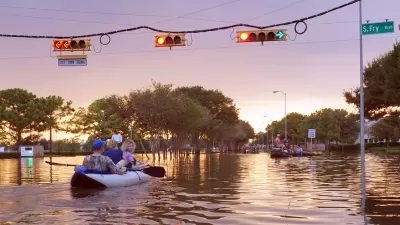Many experts believe that a property crash, as a result of Hurricanes or sea level rise, on the coast of South Florida is inevitable. But that hasn't deterred the suppliers or the consumers in the Miami real estate market.

A longform article by Nathalie Baptiste asks a big question of Florida's second-most populated city: "Why is Miami—America’s most vulnerable metropolis to sea-level rise—having yet another beachfront development boom?"
Baptiste begins by noting the current growth trend in the local development market: "The previous boom halted briefly after the 2008 collapse, but by 2011 it was on again. As of June 2015, more than 355 new towers have been proposed in South Florida." But the current optimism comes with great risk, which both consumers and suppliers seem completely blind to—whether willfully or not. Baptiste includes many pithy paragraphs to make this point, including the following:
The great cliche of the real estate business is that location is everything. That’s especially the case with buildings vulnerable to climate change. A truly green building is structurally sound, energy-efficient, low-cost, and in an area that isn’t vulnerable to sea-level rise and climate-change impacts. So a green building in a bad place is a bad building. In a place like greater Miami, the problem is both too many buildings in the wrong places, and standards that aren’t stringent enough.
Despite the billions of dollars in spending and years of planning it will take to prepare the Miami area for the effects of climate change is almost the opposite of what's happening in Miami, according to the story told in this article. Instead of planning and building safety measures, Miami is subsidizing flood insurance and incentivizing developers in risky areas.
FULL STORY: That Sinking Feeling

Maui's Vacation Rental Debate Turns Ugly
Verbal attacks, misinformation campaigns and fistfights plague a high-stakes debate to convert thousands of vacation rentals into long-term housing.

Planetizen Federal Action Tracker
A weekly monitor of how Trump’s orders and actions are impacting planners and planning in America.

In Urban Planning, AI Prompting Could be the New Design Thinking
Creativity has long been key to great urban design. What if we see AI as our new creative partner?

Cal Fire Chatbot Fails to Answer Basic Questions
An AI chatbot designed to provide information about wildfires can’t answer questions about evacuation orders, among other problems.

What Happens if Trump Kills Section 8?
The Trump admin aims to slash federal rental aid by nearly half and shift distribution to states. Experts warn this could spike homelessness and destabilize communities nationwide.

Sean Duffy Targets Rainbow Crosswalks in Road Safety Efforts
Despite evidence that colorful crosswalks actually improve intersection safety — and the lack of almost any crosswalks at all on the nation’s most dangerous arterial roads — U.S. Transportation Secretary Duffy is calling on states to remove them.
Urban Design for Planners 1: Software Tools
This six-course series explores essential urban design concepts using open source software and equips planners with the tools they need to participate fully in the urban design process.
Planning for Universal Design
Learn the tools for implementing Universal Design in planning regulations.
Appalachian Highlands Housing Partners
Gallatin County Department of Planning & Community Development
Heyer Gruel & Associates PA
Mpact (founded as Rail~Volution)
City of Camden Redevelopment Agency
City of Astoria
City of Portland
City of Laramie





























